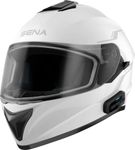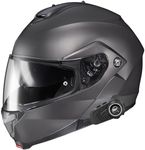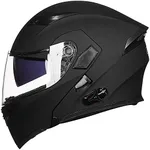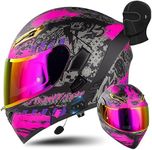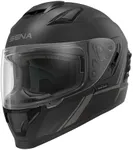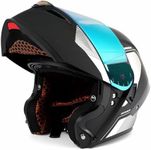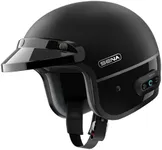Buying Guide for the Best Bluetooth Integrated Motorcycle Helmet
Choosing the right Bluetooth-integrated motorcycle helmet is crucial for ensuring safety, comfort, and connectivity while riding. A Bluetooth-integrated helmet allows you to communicate with other riders, listen to music, and receive GPS directions without the need for additional devices. To make an informed decision, you need to consider several key specifications that will help you find the best fit for your needs.Safety RatingsSafety ratings are certifications that indicate the helmet has passed certain safety tests. Common ratings include DOT (Department of Transportation), ECE (Economic Commission for Europe), and Snell. These ratings are important because they ensure the helmet can protect you in the event of an accident. For most riders, a helmet with a DOT or ECE rating will suffice, but if you want extra assurance, look for a Snell rating. Always prioritize safety ratings to ensure maximum protection.
Bluetooth VersionThe Bluetooth version determines the quality and reliability of the wireless connection. Newer versions, like Bluetooth 4.0 and above, offer better connectivity, longer range, and lower power consumption. This is important for maintaining a stable connection while riding. If you plan to use the helmet for long rides or in areas with potential interference, opt for a helmet with the latest Bluetooth version to ensure seamless communication and audio quality.
Battery LifeBattery life indicates how long the helmet's Bluetooth system can operate on a single charge. This is crucial for long rides where you need continuous connectivity. Battery life can range from a few hours to over 20 hours. If you frequently go on long trips, choose a helmet with a longer battery life to avoid the inconvenience of frequent recharging. For shorter commutes, a helmet with moderate battery life should be sufficient.
Fit and ComfortFit and comfort are essential for ensuring that the helmet can be worn for extended periods without causing discomfort. Helmets come in various sizes and shapes, so it's important to try them on to find the best fit. Look for features like adjustable padding, ventilation, and weight. A well-fitting helmet should be snug but not too tight, and it should not cause pressure points. Prioritize comfort to ensure you can focus on the road without distractions.
Audio QualityAudio quality refers to the clarity and volume of the sound produced by the helmet's speakers. This is important for clear communication and an enjoyable listening experience. High-quality audio ensures you can hear GPS directions, music, and calls clearly, even at high speeds. If you value audio performance, look for helmets with noise-canceling features and high-definition speakers. For casual use, standard audio quality may be sufficient.
Ease of UseEase of use encompasses how simple it is to operate the helmet's Bluetooth features. This includes the placement and functionality of buttons, voice command capabilities, and the user interface. A helmet that is easy to use allows you to focus on riding rather than fumbling with controls. If you prefer hands-free operation, look for helmets with intuitive voice commands. For those who like manual control, ensure the buttons are easily accessible and responsive.
Intercom RangeIntercom range is the maximum distance over which the helmet can communicate with other Bluetooth helmets. This is important for group rides where you need to stay in touch with fellow riders. Intercom ranges can vary from a few hundred meters to several kilometers. If you often ride in groups, choose a helmet with a longer intercom range to maintain communication over greater distances. For solo riders or short distances, a shorter range may be adequate.


